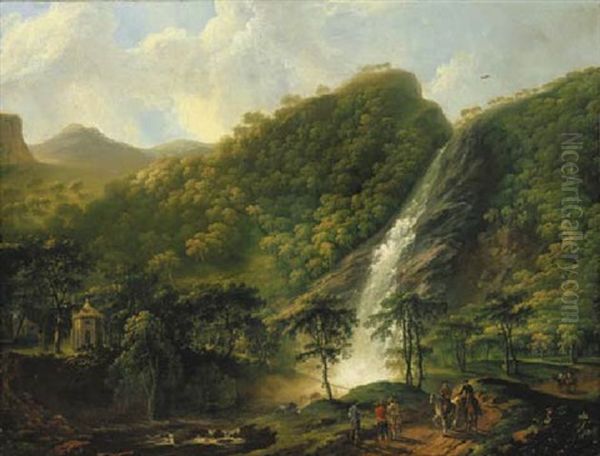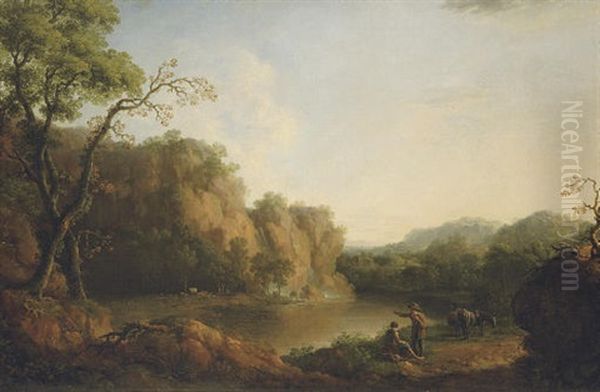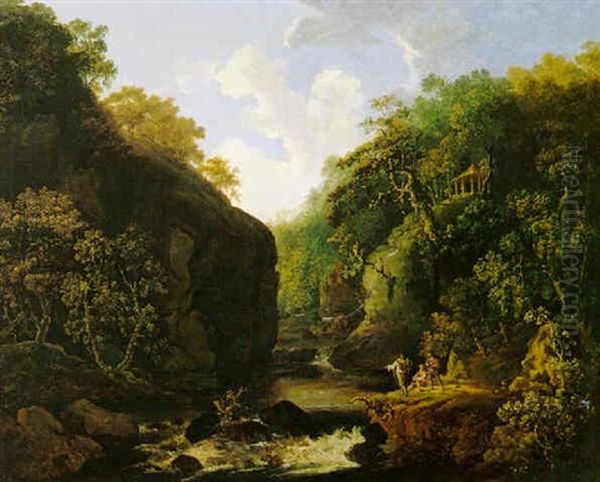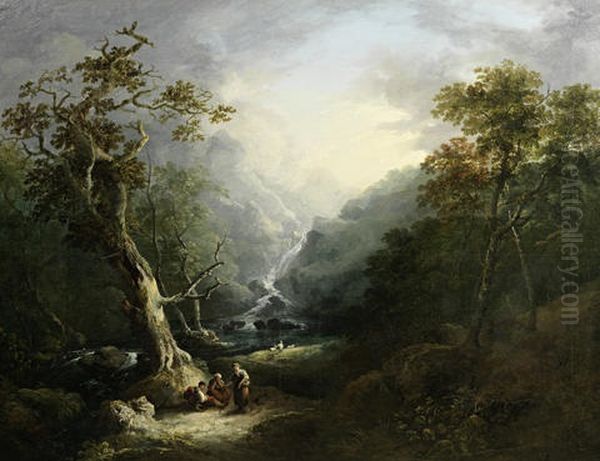Introduction: An Irish Talent in London

George Barret the Elder (c. 1728/1732 – 1784) stands as a significant figure in the history of British and Irish art. An acclaimed landscape painter, he was born in Dublin but achieved his greatest fame after moving to London. Barret was not only celebrated for his evocative depictions of the British countryside but also played a crucial role in the establishment of a cornerstone institution: the Royal Academy of Arts, of which he was a founding member. Working primarily in oils, but also proficient in watercolour, Barret captured the specific atmosphere and verdant beauty of his adopted homeland, contributing significantly to the growing appreciation for native scenery in 18th-century Britain.
Early Life and Artistic Beginnings in Dublin
Details surrounding George Barret's exact birth year vary slightly, often cited as 1728 or 1732. He was born in the Liberties area of Dublin, the son of a cloth merchant. Initially, it seems he was apprenticed not in the arts, but possibly in stay-making or cloth finishing, reflecting his family background. However, his artistic inclinations soon became apparent. He sought training under Robert West at the Dublin Society's drawing school on George's Lane, a key institution for nurturing artistic talent in Ireland at the time.
His talent for landscape painting emerged early. A pivotal moment in his Irish career came through the patronage of Edmund Burke, the influential statesman and philosopher, whom Barret had met possibly through sketching trips in the scenic Dargle Valley. Burke recognized Barret's potential and is believed to have introduced him to the Right Honourable William Powerscourt. This connection led to a significant commission to paint views of the Powerscourt estate in County Wicklow, including its famous waterfall. These early works already demonstrated his skill in capturing the specific character of the Irish landscape.
The Move to London and Establishing a Reputation
Around 1762, encouraged by Edmund Burke and seeking greater opportunities, George Barret moved to London. This was a pivotal decision that launched his career onto a larger stage. London, as the burgeoning centre of the British art world, offered more extensive patronage and exhibition possibilities than Dublin. Barret quickly found success, his fresh, naturalistic landscapes appealing to collectors weary of the dominant Italianate style.

He began exhibiting his work, initially with the Society of Artists of Great Britain, where his paintings garnered positive attention. His skill attracted high-profile patrons, including the Duke of Buccleuch and Lord Dalkeith, for whom he undertook commissions to paint views of their estates. His reputation grew rapidly, and contemporary accounts suggest that by the mid-1760s, he was earning a substantial income, perhaps around £2,000 per year – a testament to his popularity among the aristocracy and gentry who were increasingly commissioning views of their own lands.
A Founding Father of the Royal Academy
Barret's ambition and standing within the London art community led him to become involved in the politics and organization of the art world. Dissatisfaction arose among some leading artists regarding the management and direction of the Society of Artists. This culminated in a split, with a prominent group breaking away to establish a new institution under royal patronage.
In 1768, George Barret was among the key figures who founded the Royal Academy of Arts. He, along with other luminaries such as Sir Joshua Reynolds (the first President), Thomas Gainsborough, Benjamin West, Angelica Kauffman, and fellow landscape painter Paul Sandby, formed the initial cohort of Royal Academicians. This was a significant honour and cemented Barret's position at the forefront of the British art establishment. He remained a loyal contributor to the Academy's annual exhibitions for the rest of his life, showcasing his latest landscapes to a discerning public.
Artistic Style: Capturing the British Atmosphere
George Barret's art is defined by its dedication to depicting the specific character of British and Irish landscapes. His style marked a departure from the idealized, classical compositions often inspired by Italian scenery, which had been popularized by artists like Claude Lorrain and Nicolas Poussin, and adopted in Britain by painters such as Richard Wilson. While Barret certainly respected compositional structure, his focus was on the observable realities of the native environment.
He became particularly renowned for capturing what contemporaries described as the "rich, moist, spring freshness" of the British Isles. His palette often emphasized vibrant greens, conveying the lushness of foliage under humid skies. He possessed a remarkable ability to render atmospheric effects – the play of sunlight breaking through clouds, the soft haze of distance, the reflections on water. His handling of light and shadow was considered a particular strength, adding drama and realism to his scenes.

Barret worked proficiently in both oil paint and watercolour. His major commissions were typically executed in oils, allowing for rich textures and tonal depth. However, he also produced exquisite watercolours, demonstrating a lighter touch and sensitivity to the medium's transparency. While generally praised for his naturalism and technical skill, some critics occasionally found his work could tend towards a certain formalism or mannerism, perhaps a lingering influence of classical landscape conventions in structuring his views. Nonetheless, his approach represented a significant step towards the Romantic appreciation of nature for its own sake.
Subjects and Representative Works
Barret's subject matter was drawn primarily from the landscapes he encountered. He painted extensively across England, Wales, and Scotland, as well as his native Ireland. His patrons commissioned views of their country estates, parks, and surrounding scenery. Popular locations featured in his work include the Lake District, various parts of Wales known for their dramatic beauty, the environs of London such as Richmond and Windsor, and numerous private parks.
Among his most celebrated early works are the views of Powerscourt, County Wicklow, which helped establish his reputation before he even left Ireland. Powerscourt Waterfall is a prime example of his ability to capture both the grandeur and specific details of a natural landmark.
Later, his London-based career produced numerous significant landscapes. While specific titles varied, works depicting scenes like Windsor Great Park were common. One documented work, Sunset and Ruins, exemplifies his skill in rendering light effects. The painting reportedly uses warm orange and red-grey tones to capture the evocative atmosphere of twilight settling over classical ruins, blending natural observation with a touch of romantic sensibility. Another example, potentially The Great Park, Windsor, executed in watercolour and ink, showcases his delicate handling of the medium and his ability to create poetic, detailed landscape vignettes, sometimes incorporating animals.
Collaborations and Contemporary Context
In the collaborative spirit sometimes found in 18th-century art practice, Barret occasionally worked with other artists. Most notably, he collaborated with the animal painter Sawrey Gilpin. In these joint works, Barret would typically paint the landscape setting, while Gilpin, known for his skill in depicting horses and cattle, would add the animal figures, creating a more animated scene. This partnership combined the strengths of both artists.
Barret operated within a vibrant and competitive London art world. He maintained friendships, such as with the history painter James Barry, another Irish artist in London who had initially supported his exhibition efforts. He was a contemporary of the great portraitists Reynolds and Gainsborough, both of whom also painted landscapes, though often in distinctly different styles – Gainsborough with a lighter, feathery touch, and Reynolds less frequently and more formally.

Other landscape contemporaries included Richard Wilson, whose classical Italianate style provided a contrast to Barret's focus on British scenery. Paul Sandby was a key figure in developing watercolour and topographical views. Artists like Joseph Wright of Derby, famed for his dramatic light effects in industrial and scientific scenes, or William Marlow, known for his precise topographical views of country houses and river scenes, also formed part of the artistic milieu. Watercolourists like Michael Angelo Rooker and genre/landscape painters like Francis Wheatley further populated this diverse scene. Barret's success in securing patronage and his role in the RA demonstrate his ability to thrive amidst this talented cohort.
Later Life, Financial Struggles, and Legacy
Despite his considerable success and high earnings earlier in his career, George Barret seems to have struggled with financial management. Contemporary accounts describe him as improvident. In his later years, he suffered from asthma, which prompted him to move from central London to the then more rural setting of Westbourne Green, seeking cleaner air.
His financial difficulties became severe, and tragically, despite his status as a Royal Academician, he faced bankruptcy towards the end of his life. When he died in Paddington on March 29, 1784, he left his wife and several children (including George Barret Jr., who would also become a notable watercolour landscape painter) in difficult circumstances. Recognizing his contribution as a founder member, the Royal Academy awarded his widow an annual pension, providing some relief for the family.
George Barret the Elder's legacy lies in his significant contribution to the development of British landscape painting. He was among the first highly successful artists to dedicate his career primarily to depicting native scenery, capturing its unique character and atmosphere with skill and sensitivity. His work helped elevate landscape painting's status in Britain and paved the way for later masters like John Constable and J.M.W. Turner. As a founding member of the Royal Academy, he also played an instrumental role in shaping the institutional framework of the British art world. His paintings remain admired for their beauty, technical accomplishment, and evocative portrayal of the 18th-century British and Irish countryside, held in numerous public and private collections worldwide.
Conclusion: An Enduring Vision of Landscape

George Barret the Elder was a pivotal figure in 18th-century art. An Irish painter who found fame in London, he successfully challenged the dominance of foreign landscape models by focusing on the beauty of Britain and Ireland. His skillful rendering of light, atmosphere, and the characteristic verdancy of the land resonated with patrons and the public. As a founding Royal Academician, he helped institutionalize art in Britain. Despite personal financial struggles later in life, his artistic achievements endure. Barret's work offers a compelling vision of the natural world, blending careful observation with a poetic sensibility, securing his place as a key pioneer of the British landscape tradition.